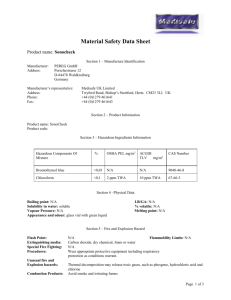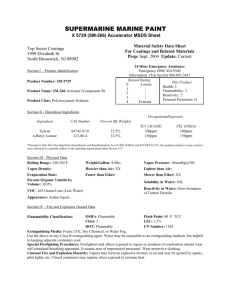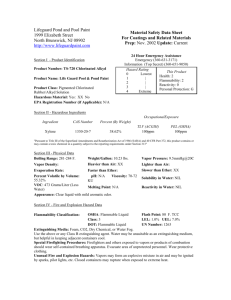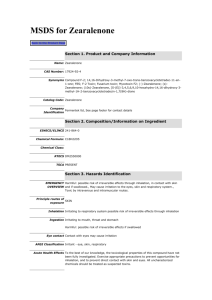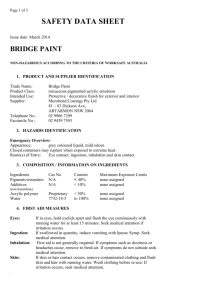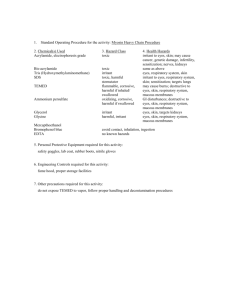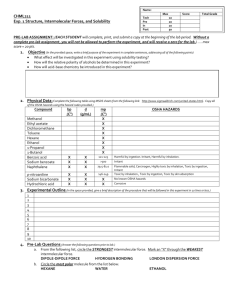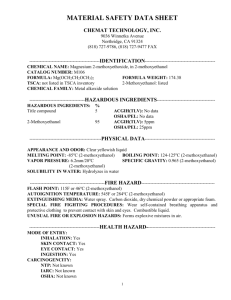MATERIAL SAFETY DATA SHEET Quantum Tecnical Services Ltd.
advertisement
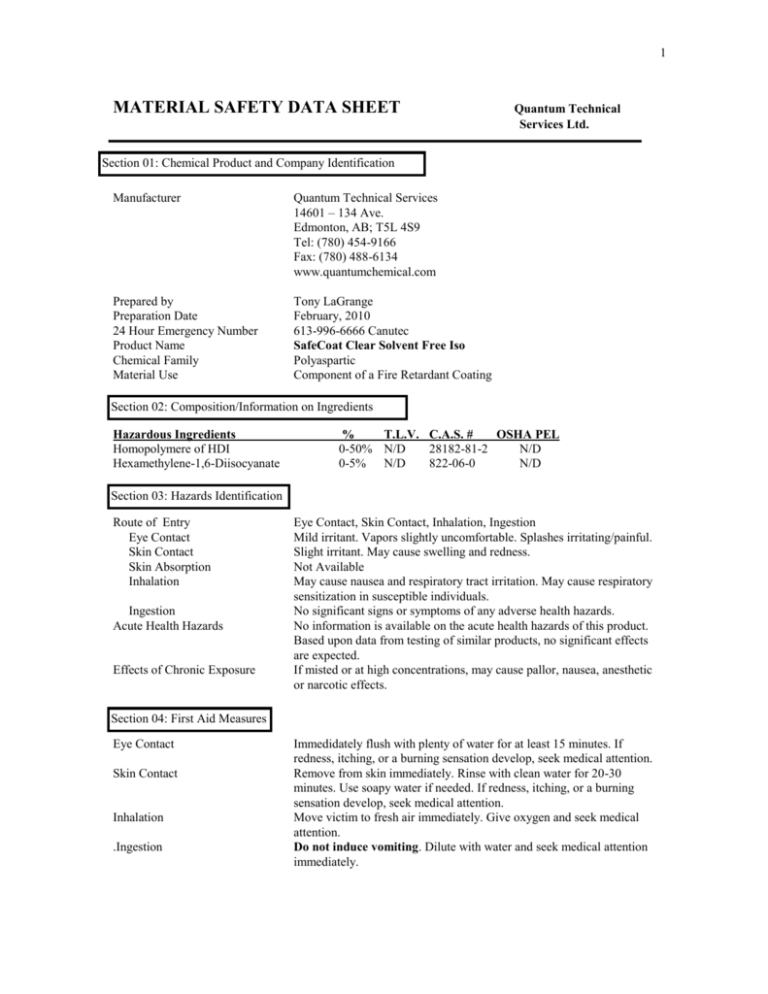
1 MATERIAL SAFETY DATA SHEET Quantum Technical Services Ltd. Section 01: Chemical Product and Company Identification Manufacturer Quantum Technical Services 14601 – 134 Ave. Edmonton, AB; T5L 4S9 Tel: (780) 454-9166 Fax: (780) 488-6134 www.quantumchemical.com Prepared by Preparation Date 24 Hour Emergency Number Product Name Chemical Family Material Use Tony LaGrange February, 2010 613-996-6666 Canutec SafeCoat Clear Solvent Free Iso Polyaspartic Component of a Fire Retardant Coating Section 02: Composition/Information on Ingredients Hazardous Ingredients Homopolymere of HDI Hexamethylene-1,6-Diisocyanate % T.L.V. C.A.S. # OSHA PEL 0-50% N/D 28182-81-2 N/D 0-5% N/D 822-06-0 N/D Section 03: Hazards Identification Route of Entry Eye Contact Skin Contact Skin Absorption Inhalation Ingestion Acute Health Hazards Effects of Chronic Exposure Eye Contact, Skin Contact, Inhalation, Ingestion Mild irritant. Vapors slightly uncomfortable. Splashes irritating/painful. Slight irritant. May cause swelling and redness. Not Available May cause nausea and respiratory tract irritation. May cause respiratory sensitization in susceptible individuals. No significant signs or symptoms of any adverse health hazards. No information is available on the acute health hazards of this product. Based upon data from testing of similar products, no significant effects are expected. If misted or at high concentrations, may cause pallor, nausea, anesthetic or narcotic effects. Section 04: First Aid Measures Eye Contact Skin Contact Inhalation .Ingestion Immedidately flush with plenty of water for at least 15 minutes. If redness, itching, or a burning sensation develop, seek medical attention. Remove from skin immediately. Rinse with clean water for 20-30 minutes. Use soapy water if needed. If redness, itching, or a burning sensation develop, seek medical attention. Move victim to fresh air immediately. Give oxygen and seek medical attention. Do not induce vomiting. Dilute with water and seek medical attention immediately. 2 Section 05: Fire Fighting Measures Flash Point Auto Ignition Temperature (C) Extinguishing Media Protective Equipment Unusual hazards Sensitivity to Mechanical Special Fire Fighting Procedures >200 degrees F (93 degrees C) Foam/Carbon dioxide/Dry chemical/Water fog Safety glasses and gloves Closed containers may rupture from build up of pressure when exposed to extreme heat. Not expected to be sensitive to mechanical impact Remove all ignition sources. Wear self-contained breathing apparatus and complete personal protective equipment when entering confined areas where potential for exposure to vapors or products exist. Section 06: Accidental Release Measures Leak/Spill Avoid contact with substance. All persons involved in clean up must be wearing appropriate protective equipment. Stop the spill at source, pump liquid to salvage container. Remaining liquid may be taken up on clay, diatomaceous earth, or other absorbent. Treat with Decontamination Solutions: Nonionic surfactant Union Carbide’s Tergitol TMN-10 (20%) and water (80%); concentrated ammonia (3-8%), detergent (2%) and water (90-95%). Section 07: Handling and Storage Handling Procedures Avoid skin and eye contact. Avoid breathing fumes. Wash thoroughly before eating or drinking. Storage Needs Store in a cool and dry place away from ignitable sources as exothermic generation of carbon dioxide may cause dangerous pressure. Store in tightly sealed containers and protect from moisture. Re-seal partially used containers. Section 08: Exposure Controls/ Personal Protection Protective equipment Eye/Type Respiratory/Type Gloves/Type Clothing/Type Other/Type Ventilation Requirements Chemical tight goggles; full face shield if possibility of splashing. Respiratory masks should be worn at all times in the case of inadequate ventilation. A NIOSH/MSHA respirator is acceptable. Use neoprene or rubber gloves. Wear adequate protective coveralls and footwear. Eyewash fountain. Emergency shower should be in close proximity. Ventilate adequately. Local exhaust may be required in certain instances and mechanical exhaust is usually sufficient. Section 09: Physical and Chemical Properties Physical State Appearance Odor Specific Gravity Vapor Pressure (mm Hg) Liquid Clear/pale yellow Slightly musty. 1.15 @ 25 degrees C Approx. 5.2x10-9 3 Vapor Density (Air=1) Evaporation Rate Boiling Point pH Solubility in water Freezing Point (o C) Melting Point Percent Solids by Weight Percent Volatile (g/l) VOC (g/l) Viscosity No Data No Data 3820 Fahrenheit No Data Insoluble in water @ 680F (200C) N/D N/D 9.6 lb./gal 0% by weight; 0% by volume 0% with water; 0% without water 650-750 Section 10: Stability and Reactivity Stability Conditions to avoid Incompatibility Reactivity Conditions Hazardous products of Decomposition Conditions to avoid Stable Excessive heat, open flame, sparks, and strong oxidizing agents Protect from atmospheric moisture. Replace outage with inert dry nitrogen. Water, acid, base (alkalis, ammonia), alcohols, metal compounds See “incompatibility” Isocyanate vapors or mist, carbon dioxide, carbon monoxide, nitrogen oxides Avoid incompatible reactants, especially strong bases, water or temperatures over 1600 C. Section 11: Toxicological Information Acute Oral Toxicity(LD50) Dermal (LD50) Inhalation (LC50) >10000 mg/Kg (rats) >5000 mg/Kg (rabbits) Lower respiratory (pulmonary) irritant LC50 Value Range from 137-1150 MG/M3 were obtained in rats exposed to aerosols. (4H EXP.) Severe irritant Capable of inducing corneal injury (rabbit) Maximum primary eye irritant score: 54.6/110 for 24 hour skin effects: Moderate and Dermal. Primary dermal irritation score: 3.4/8.0 (rabbit). Sensitizing Capability of Material Carcinogenity of Material Teratogenicity Mutanagenity Reproductive Effects Synergistic Materials Pulmonary and dermal sensitizer in animals and humans. Not classified as carcinogenic Not available Not available Not available None known Section 12: Disposal Considerations Waste Disposal In accordance with municipal, provincial and federal regulations. Empty containers must be handled with care due to product residue. Do not heat or cut empty containers with electric or gas torch. 4 Section 13: Transport Information Proper Shipping Name Hazard Class: Polyisocyanate Non-regulated in 55 gallon drums, NOI Section 14: Regulatory Information TSCA (Toxic Substance Control Act) If exported to the United States all chemical substances in this shipment comply with all applicable rules or orders under TSCA and there are no chemical substances in violation of TSCA or any applicable rule or order thereunder. Section 15: Other Information Note This information is furnished without warranty, expressed or implied, except that it is accurate to the best knowledge of Quantum Technical Services Limited. The data on this sheet relates only to the specific material designated herein. Quantum Technical Services Ltd. assumes no legal responsibility for use or reliance upon these data.
